Contents
Blackcurrant is a unique plant in many ways. Few berry bushes are distinguished by the same unpretentiousness, ease of cultivation and stable yield. However, you can use not only the berries of this plant. Many gardeners harvest currant leaves for drying and then use them for culinary and medicinal purposes.
Useful properties of dried currant leaves
The healing power of blackcurrant fruits has long been known. However, its leaves contain no less useful substances than berries. Many gardeners are aware of this, therefore, at the same time as harvesting the berries, young currant leaves are harvested and dried.
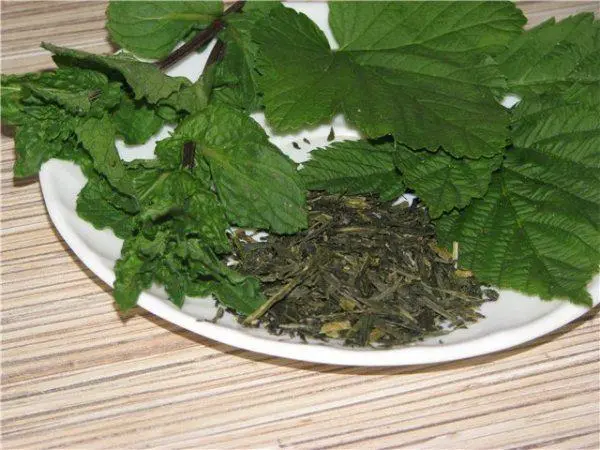
Among the useful substances that they contain, the following can be noted:
- vitamins;
- microelements;
- antioxidants;
- essential oils;
- biologically active substances;
- organic acids, etc.
Drying is the easiest and most reliable way to harvest a currant leaf for future use. It is important that most of the nutrients are preserved unchanged. In the future, such dried plant materials are used to prepare decoctions, infusions and vitamin tea.
When is the best time to collect currant leaves for drying?
The content of nutrients in currant leaves reaches its highest concentration during the flowering period. It is at this time that it is best to produce their preparation for drying. However, this does not mean that the currant leaf cannot be harvested at other times. Experienced herbalists harvest the material gradually, throughout the season, carefully selecting it and discarding it.
In order not to weaken the currant bush before fruiting, do not pick off too many leaves before harvesting. The main amount of plant material should be plucked only after all the berries have been harvested. In addition, harvesting should be postponed if currants were treated with fungicides or pesticides for diseases and pests the day before.
How to collect currant leaves for drying
Currant leaves for drying are harvested on a fine day, in the morning, while there is no bright sun. It is necessary to carefully cut them off along with the petioles, while rejecting the damaged ones. Do not take dirty leaves, as well as those affected by diseases or pests. The leaf plate should be even, not have yellowness and rot. First of all, they take the apical leaves of young annual shoots, they are the most juicy and fragrant.
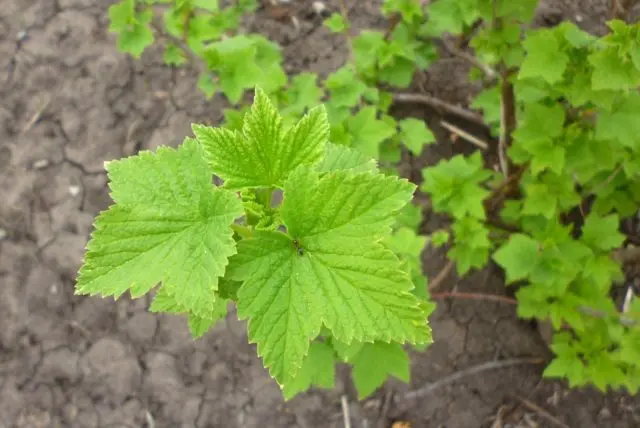
If a lot of raw materials are required, then they are plucked from older branches, paying attention to quality.
How to dry currant leaves
It is possible to dry the collected currant leaves both in natural conditions and using various heating devices for this. If the drying process is carried out correctly, the currant leaf will retain its aroma and beneficial properties.
On air
Weather permitting, currant leaves can be air-dried by spreading them in a thin layer in the shade. As a substrate, you can use a sheet of clean paper, a metal baking sheet, plywood. The place should be well ventilated, but protected from direct sunlight. The summer veranda of the house, terrace, canopy are well suited for drying. In the garden, it is best to use the attic of a country house for this purpose. You can dry currants at home on the windowsill or on the balcony. From above, the pallet with raw materials can be closed with a cut of clean gauze.
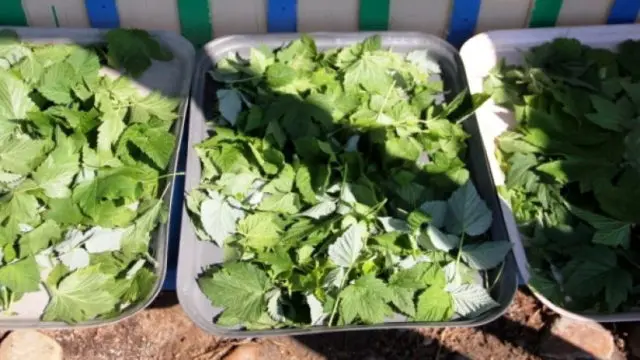
Periodically harvested green mass must be stirred and turned over so that it dries evenly. If the air humidity is high, then you need to make sure that mold does not start to appear on the raw materials. Such copies are subject to immediate removal and destruction. Total drying in the open air can take quite a long time, since the process is highly dependent on the temperature and humidity of the surrounding air. Sometimes it can take 1-1,5 weeks to completely dry.
In the oven
If weather conditions or other circumstances do not allow drying the harvested greens in the open air, then this can be done using the oven. Raw materials are laid out in a small layer on a baking sheet, and then placed in an oven preheated to 100 ° C. After 1,5 hours, the temperature is reduced to 50-60 ° C and the leaves are dried until tender. It should be remembered that the oven door must be constantly ajar during drying so that moisture can easily evaporate. It is advisable to turn on the convection mode in the oven (if available).
In an electric dryer
In order to dry currant leaves for tea, a standard electric dryer is quite suitable. Just like in the oven, the raw materials are laid out in a thin layer on a baking sheet and dried with the door ajar at medium temperature. The whole drying process can take 3-4 hours, if during this time the leaves do not acquire characteristic brittleness, then the process is continued. At the same time, the current moisture content of the leaves is checked every half hour.
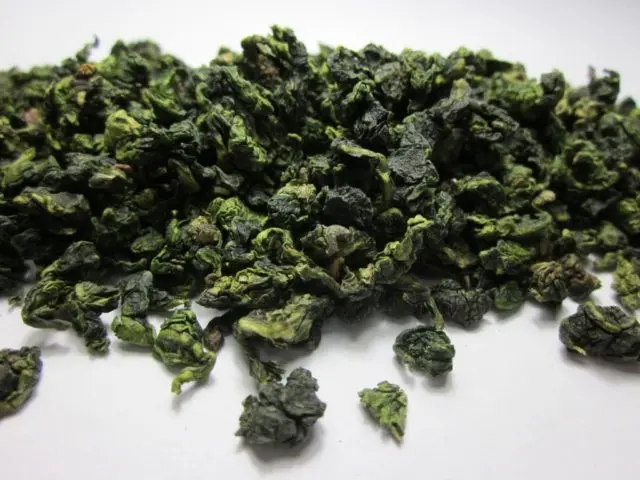
Often, currant leaves are fermented before drying. This procedure enhances the aroma of vegetable raw materials, and at the same time relieves it of the characteristic smell of hay. In order to start the fermentation mechanism, the currant leaves are twisted into a tight tube until the juice is released. The folded tubes are placed in a clean dish, covered with a clean piece of cloth and placed under oppression. A day later, when the cell sap contained in the leaves is fermented, the tubules will acquire a strong fruity aroma. After that, they can be taken out, cut into slices and dried in the oven.
Video on how to harvest and dry currant leaves for tea:
Application of dried currant leaf
The most common purpose of dried currant leaves is as a tea leaves. In addition, their infusion can also be used for medical purposes.
In cooking
Currant leaf is used in many canning recipes. It is added when pickling cucumbers, tomatoes, zucchini, apples, mushrooms. It is preferable to use fresh currant leaves for these purposes, but nothing prevents them from using dried ones instead, if the greens are no longer on the bushes at this time. Often, dried currant leaves are added to berry fruit drinks and mousses, as well as to alcoholic drinks infused with berries and herbs.
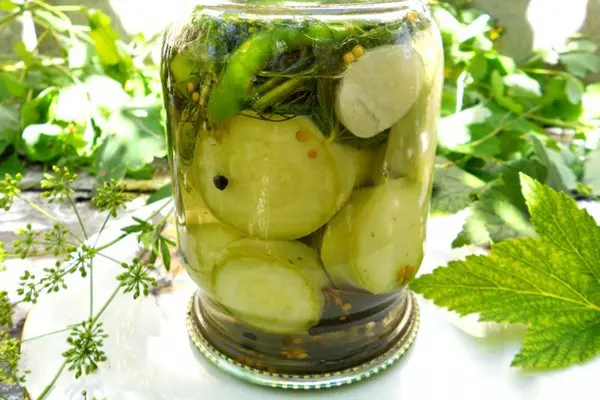
However, most gardeners who harvest dried currant leaves use it for brewing instead of traditional tea. Such a drink is a wonderful tonic, it is not only tasty, but also healthy.
In folk medicine
Currant leaf has many useful properties. Tea from it strengthens the immune system, has an antipyretic and analgesic effect, therefore it is recommended for colds. It is also used as a diuretic. Currant tea is recommended for atherosclerosis, diabetes, anemia. The infusion has bactericidal properties, it can be used externally as a wound disinfectant. In cosmetology, a decoction of currant leaves is used for washing and cleansing the skin. For the treatment of acne, a mask with gruel from crushed currant leaves is often used.
Terms and conditions of storage of dried currant leaves
Store dried currant leaves in a dry, dark place. So that the prepared raw materials do not lose their aroma, it is better to use tightly closed ceramic or glassware for storage. Such packaging is guaranteed to save currant leaves from mixing with extraneous aromas and odors. For storage of plant materials, you can use tight-fitting plastic opaque food containers, which are sold in hardware stores. They are quite roomy and functional, they are convenient to store. At the time of laying the raw materials, the container must be absolutely clean and dry, otherwise mold may develop.
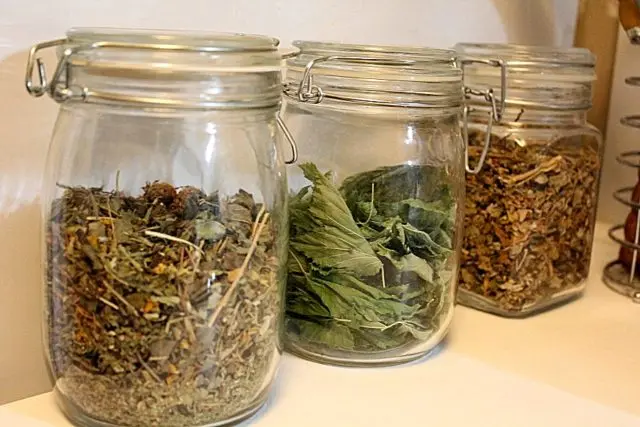
Often, paper bags or canvas bags are used to store dry currant leaves. When storing raw materials, they must be closed or tied, and next to them there should not be any other herbs or spices with a pungent odor. Subject to all storage conditions, dry currant leaves can be stored without loss of medicinal and culinary properties for 3 years. However, if fresh plant materials are available, there is no need to keep the blanks for such a long time, therefore, the stock is usually made in such a way that it is enough until fresh greens appear on the currant bushes.
Conclusion
Some lovers of exotic tastes collect currant leaves for drying, and then mix them with other herbal ingredients, such as dried fireweed or raspberries. Such mixes have not only a rich harmonious taste, they are also much more useful than each individual component. Herbal tea prepared in this way is guaranteed to exist only in a single copy, and its taste and aroma can surprise and please not only the gardener himself, but also his guests.









